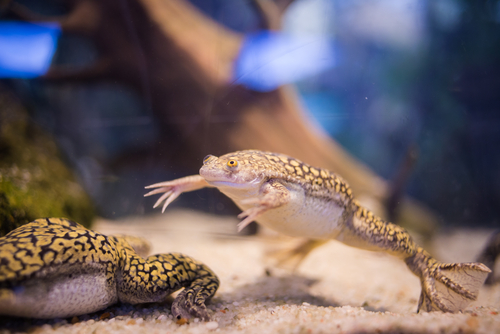When selecting the ideal tank mates for African clawed frogs, size counts. They are the perfect size for the frog to consume—neither too big nor too little.
The best African Clawed Frog Tank Mates mates are:
- Nerite Snails
- Mystery Snails
- Fancy Guppies
- Platies
- Endlers
- Neon Tetras
- Cardinal Tetras
- Rummy Nose Tetras
- Black Skirt Tetras
- Corydoras Catfish
- Zebra Danio
- Cherry Barbs
Your best option is a small, calm schooling fish, and in this post, I’ll introduce you to my favorite tank mates for African clawed frogs.
Contents
African Clawed Frog Tank Mates – What You Need To Know
Temperament
No matter how big they are, specific fish species are jerks. African Clawed Frogs are very peaceful creatures that don’t do well in environments with aggressive species.
It’s true for some people too, which is not a significant surprise.
However, you should stay away from fish that are considered to be hostile or semi-aggressive. Even while a toothy, combative fish probably couldn’t devour a frog whole in one meal, repeated bites may cause major harm to the poor, defenseless froggies.
Size
The average length of an African clawed frog is less than 3in (7.5 cm).
They thus thrive in tanks with smaller tankmates.
Your frogs’ risk being nipped at, tormented, and even devoured by larger fish.
You should only introduce fish that are 3 inches (7.5 cm) or less, in my opinion. Your frogs will not be served this way.
Competition
African Clawed frogs are very naturally peaceful and unlikely to be competitive with any of their tank mates. This means they will thrive best with other species that are similarly peaceful.
Tank Setup and Parameter
To provide refuge for your frogs, use some vast stones and snags. As for tank plants, you may use both real and fake ones. It is preferable to use massive, coarse-leaved plants in flower pots because these frogs like chewing on soft tank plants.
Tank water must be kept at a temperature of around 21–27 °C (70–81 °F), often achieved using the room’s central heating system. However, if the temperature falls below 20 °C, you must install a heater inside the tank.
It’s best to keep African clawed frogs and aquarium fish apart; each frog’s tank should have at least 40 liters (8.8 gallons) of water. You may also maintain one in such a tank, but they behave better and look better when others of their species accompany them.
They may also be maintained in a group with one male and many females, but because of the possibility of competition, you should avoid keeping male species in the same tank.
The Best African Clawed Frog Tank Mates
You don’t also want to miss:
1. Nerite Snails
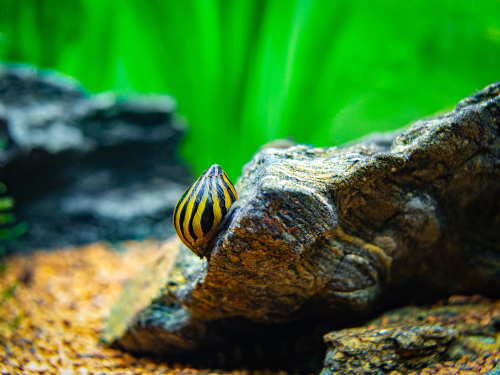
- Scientific Identifier: Nerita
- Mature Size: 1 inch (2.5 centimeters)
- Compatible with: the majority of fish and invertebrates suitable for a communal freshwater tank
- Water Temperature: 65°-85°F (18°-29°C)
- Smallest Tank Capacity: 5 gallons (19 liters)
- Care Level: Beginner
- Provenance: Africa
My first pick for an algae-eating snail is a nerite. The perfect thing is that they don’t breed in freshwater and are available in a vast selection of hues and designs. They deposit eggs that adhere to rocks and other decorations, which can be a little unpleasant, but the eggs will only develop in brackish water, which is the only major drawback to these snails.
Pros:
- Beautiful
- Algae eaters
- Don’t reproduce in freshwater
Cons:
- Can escape their tank
- Will lay eggs even though they can’t reproduce in freshwater
2. Mystery Snails
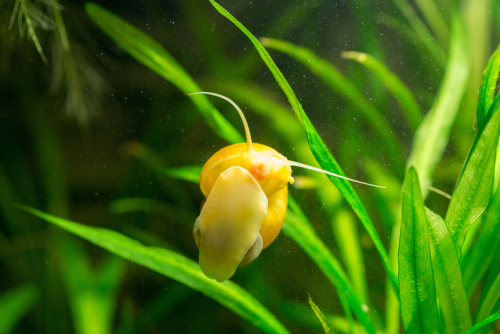
- Scientific Identifier: Pomacea bridgesii
- Mature Size: 1 inch (2.5 centimeters)
- Compatible with: freshwater shrimp
- Water Temperature: 65°-82°F (18°-28°C)
- Smallest Tank Capacity: 5 gallons (19 liters)
- Care Level: Beginner
- Provenance: Asia
Very adorable are mystery snails. They have incredibly long antennae that whip around as they float about the tank, which I find charming. They are excellent at consuming algae and food remaining at the tank’s bottom.
In a home tank, they can procreate, but only if you have a male and a female; thus, keeping only one snail will avoid unwanted offspring. Mystery snails deposit their eggs above the water’s surface so that you may remove the clutch if you spot it before the eggs develop.
Pros:
- Nice looking
- Active
- Borrow and prevent gas pockets
Cons:
- Lays many eggs above the surface
3. Fancy Guppies
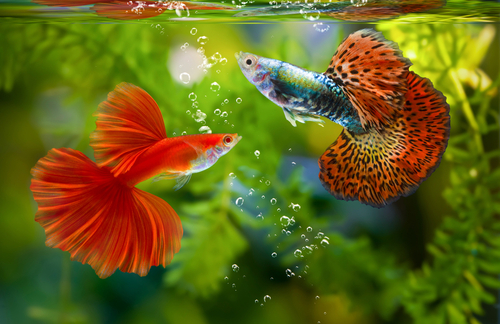
- Scientific Identifier: Poecilia reticulata
- Mature Size: 1.5 inches (4 centimeters)
- Compatible with: Platies
- Water Temperature: 75-80°F (24°-27°C)
- Smallest Tank Capacity: 5 gallons (19 liters)
- Care Level: Beginner
- Provenance: South America
Most live fish stores have guppies, which are excellent beginner fish. There are several color variations that you may combine. You can maintain a male to every three females in a mixed tank. You may also have a tank that is all male and appreciate the wild colors.
Pros:
- Doesn’t lay a lot of eggs
- Easy to find
Cons:
- Fragile
4. Platies
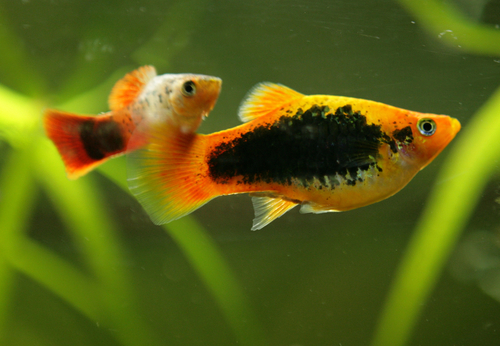
- Scientific Identifier: Xiphophorus maculatus
- Mature Size: 2 in (5 centimeters)
- Compatible with: Mollies
- Water Temperature: 75-80°F (24°-27°C)
- Smallest Tank Capacity: 5 gallons (19 liters)
- Care Level: Beginner
- Provenance: Central America
The tranquil schooling fish known as platies is quite active. The one issue you could encounter if you keep this species alongside frogs is that they could suddenly swoop in and consume the frog’s food before it can be consumed.
These tiny creatures are adorable, but a school of them is like a small fish tornado. Platies are pretty friendly, so a group setting is excellent for them.
Pros:
- Community fish
- Not prone to disease
Cons:
- Susceptible to water temperature changes
5. Endlers
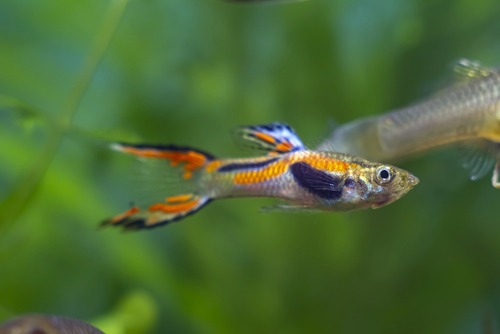
- Scientific Identifier: Poecilia wingei
- Mature Size: 1.5 inches (4 centimeters)
- Compatible with: Cory Catfish
- Water Temperature: 75-80°F (24°-27°C)
- Smallest Tank Capacity: 5 gallons (19 liters)
- Care Level: Beginner
- Provenance: South America
Endlers have a technicolor guppie appearance. Seriously, the men resemble children who have drawn a beautiful fish for you using every crayon in the box. These are blood cousins of the guppy and, in my view, are even more gorgeous. These small fish are very, very quiet and undemanding.
Pros:
- Low maintenance
- Colorful and beautiful
Cons:
- Can breed a lot if not monitored
6. Neon Tetras
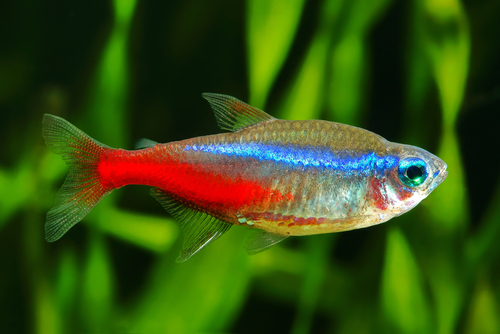
- Scientific Identifier: Paracheirodon innesi
- Adult Size: 1.5 inches (4 centimeters)
- Compatible with: Harlequin Rasboras
- Water Temperature: 68°-82°F (10°-28°C)
- Smallest Tank Capacity: 5 gallons (19 liters)
- Care Level: Beginner
- Provenance: South America
One of the most beloved fish in the aquarium hobby are these little beauties. They are remarkably tranquil. For neons to be truly happy, they must be maintained in groups of 5 or more.
Check to see whether your tank has enough space to hold a school. I heartily suggest these tiny gentlemen. They are adorable and simple to maintain.
Pros:
- Easy to care for
- Colorful and beautiful
- Long lifespan
Cons:
- Can’t live alone
- Susceptible to disease
7. Cardinal Tetras

- Scientific Identifier: Paracheirodon axelrodi
- Mature Size: 3 in (5 centimeters)
- Compatible with: Corydoras
- Water Temperature: 70°-85°F (21°-29°C)
- Smallest Tank Capacity: 15 gallons (57 liters)
- Care Level: Beginner
- Provenance: South America
Neon tetras and cardinal tetras are somewhat similar fish. However, the latter is slightly bigger. They are a fantastic directed learner who thrives in a bigger planted tank.
Pros:
- Colorful
- Friendly with other fish
- Active
Cons:
- Skittish
- Susceptible to overcrowding
8. Rummy Nose Tetras
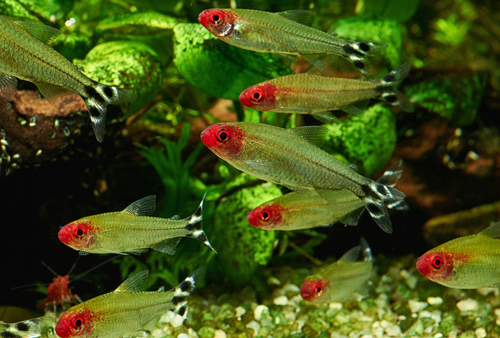
- Scientific Identifier: Hemigrammus rhodostomus
- Mature Size: 1.5 inches (4 centimeters)
- Compatible with: Green Neon Tetra
- Water Temperature: 64°-82° F (18°-27.7° C)
- Smallest Tank Capacity: 10 gallons (39 liters)
- Care Level: Beginner
- Provenance: South America
In a tank, these colorful tiny fish are always rather stunning. They devour most feeds and are relatively low maintenance. To prevent them from being very anxious and uncomfortable, they must be maintained in groups of five or more.
Pros:
- Peaceful
- Unique appearance
Cons:
- Easily stressed
- Not compatible with bigger fish
9. Black Skirt Tetras
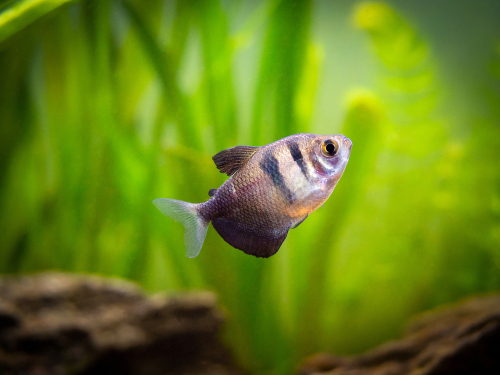
- Scientific Identifier: Gymnocorymbus ternetzi
- Mature Size: 2.5 inches (6 centimeters)
- Compatible with: Harlequin Rasbora
- Water Temperature: 72°-82°F (22°-28°C)
- Smallest Tank Capacity: 15 gallons (57 liters)
- Care Level: Beginner
- Provenance: Brazil
Black skirt tetras, often known as black widow tetras, are timid small schooling fish with a very calm disposition. When they feel shy, towering plants and a lot of hiding places are excellent for them. Another schooling fish requires a group size of five or more to feel comfortable.
Pros:
- Peaceful
- Active
Cons:
- Don’t do well alone
10. Corydoras Catfish
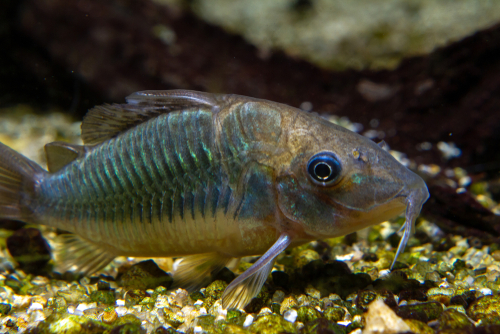
- Scientific Identifier: Corydoras
- Mature Size: 1-4 inches (2.5-10 centimeters)
- Compatible with: Mollies
- Water Temperature: 72°-82°F (22°-28°C)
- Smallest Tank Capacity: 20 gallons (76 liters)
- Care Level: Beginner
- Provenance: South America
Corydoras catfish come in over 161 species, many of which are sold in the aquarium trade. Verify again because some species can grow larger than 3 inches (7.5 centimeters). I adore Corydoras because they enjoy playing around and swimming in large schools around the bottom (you should keep five or more).
They are incredibly tranquil and available in various sizes and colors. They are excellent small bottom feeders that will search the substrate for food that hasn’t been consumed.
Keeping corydoras in a tank with a sand substrate is ideal since they spend much of their day digging in the substrate. Sharp surfaces can harm the fragile barbels that round their lips.
Pros:
- Peaceful
- Clean their tank
Cons:
- Don’t do well alone
11. Zebra Danios
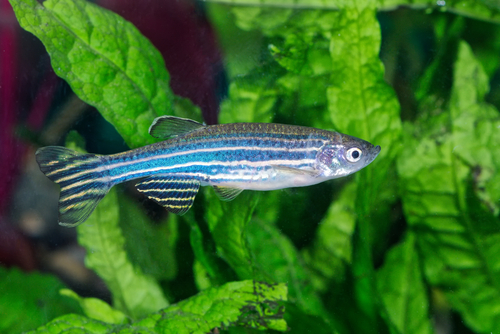
- Scientific Identifier: Danio rerio
- Mature Size: 2 inches (5 centimeters)
- Compatible with: Ember Tetras
- Water Temperature: 65°-75°F (18°-24°C)
- Smallest Tank Capacity: 20 gallons (76 liters)
- Care Level: Beginner
- Provenance: South Asia
The hyperactive zebra danios fish love to swim around the tank. Although they can technically be maintained in a 10-gallon tank, I believe they must be kept in at a minimum of 20-gallon since they need a lot of space to swim. This species is relatively quiet and entertaining to observe.
Pros:
- Beautiful
- Hardy
Cons:
- Susceptible to overcrowding
12. Cherry Barbs
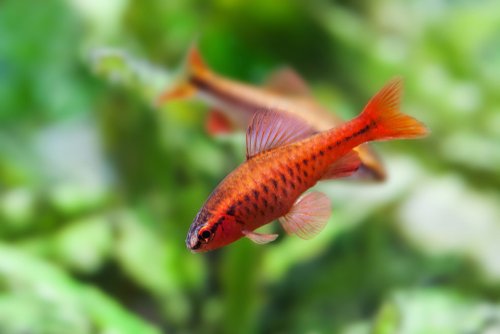
- Scientific Identifier: Puntius titteya
- Mature Size: 2 inches (5 centimeters)
- Compatible with: Otocinclus
- Water Temperature: 68°-80°F (20°-26.7°C)
- Smallest Tank Capacity: 20 gallons (76 liters)
- Care Level: Beginner
- Provenance: Sri Lanka
Cherry barbs are a fantastic little community fish that will give your community tank a splash of color. This fish has to be kept in a school of five or more since it is an active schooling fish. They thrive in tanks with open swimming regions and thickly vegetated sections.
Pros:
- Easy to care for
- Hardy
Cons:
- Sensitive to water temperature changes
Final Thoughts
The most important thing to remember is that size counts when choosing tank mates for your African Clawed frogs.
Be sure to choose tank companions that are big enough that the frogs can’t eat them but not so huge that they will devour the frogs.
Your best bet is to look for calm, little schooling fish. They might not even have regular contact with the frogs because many favor the water column’s upper regions.

Ian Sterling, founder of Fishlab.com, began his aquarium journey over 30 years ago, driven by a deep fascination for fish and their diverse personalities. His website, Fishlab.com, is dedicated to making fishkeeping accessible and enjoyable, offering beginner-friendly guidance, expert insights, and a community for aquarists to connect and share experiences.


